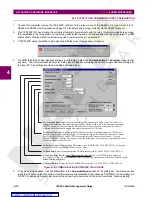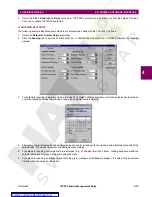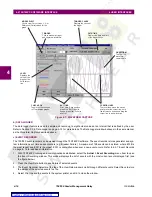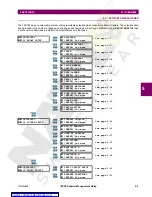
4-4
750/760 Feeder Management Relay
GE Multilin
4.1 FRONT PANEL INTERFACE
4 USER INTERFACES
4
The
key may be pressed at any time to display a list of context sensitive help messages. Continue to press the
key to display all the help messages and return to the original display.
The
key resets any latched conditions that are not presently active. This includes resetting latched output relays,
latched Trip LEDs, breaker operation failure, and trip / close coil failures. The 760 Autoreclose Scheme is also reset with
the shot counter being returned to zero and the lockout condition being cleared.
The
key scrolls through any active conditions in the relay. Diagnostic messages are displayed indicating the state of
protection and monitoring elements that are picked up, operating, or latched. When the Message LED is on there are mes-
sages to be viewed with the
key.
Pressing the
key will attempt to open the breaker connected to the Trip Relay by closing the contact. Likewise, the
key will attempt to close the breaker connected to the Close Relay by closing the contact. The
and
keys
only operate when the relay is in local mode; local mode can be enabled with a user programmed logic input.
4.1.4 MESSAGES
a) DIAGNOSTIC MESSAGES
Diagnostic messages are automatically displayed for any active conditions in the relay such as trips, alarms, or asserted
logic inputs. These messages provide a summary of the present state of the relay. The Message LED flashes when there
are diagnostic messages available; press the
key to scroll through the messages. The following shows the format of
the various diagnostic messages.
b) SELF-TEST WARNINGS
The relay performs self diagnostics at initialization (after power up), and continuously as a background task to ensure that
every testable unit of the hardware and software is alive and functioning correctly. There are two types of self-test warnings
indicating either a minor or major problem. Minor problems indicate a problem with the relay that does not compromise pro-
tection of the power system. Major problems indicate a very serious problem with the relay which comprises all aspects of
relay operation.
Self-Test Warnings may indicate a serious problem with the relay hardware!
Upon detection of either a minor or major problem, the relay will:
•
De-energize the Self-Test Warning Relay.
•
Indicate the failure in the diagnostic message queue.
•
Record the failure in the Event Recorder.
Upon detection of a major problem, the relay will (if possible) also:
•
Turn off the Relay In Service LED.
•
Inhibit operation of all output relays.
PICKUP: <F>
< Cause >
These messages show any elements that are presently picked up.
TRIP: <F>
< Cause >
These messages indicate that an element has tripped. The message remains in the
diagnostic queue until the relay is reset.
ALARM: <F>
< Cause >
These messages show any elements that are presently operating and have been pro-
grammed to have an alarm function. When an element is programmed to Latched
Alarm, this message remains in the diagnostic queue after the alarm condition clears
until the relay is reset.
SELF-TEST WARNING:
< Cause >
These messages show any self-test warnings.
HELP
HELP
RESET
NEXT
NEXT
OPEN
CLOSE
OPEN
CLOSE
NEXT
W
A
R
NIN
G











































